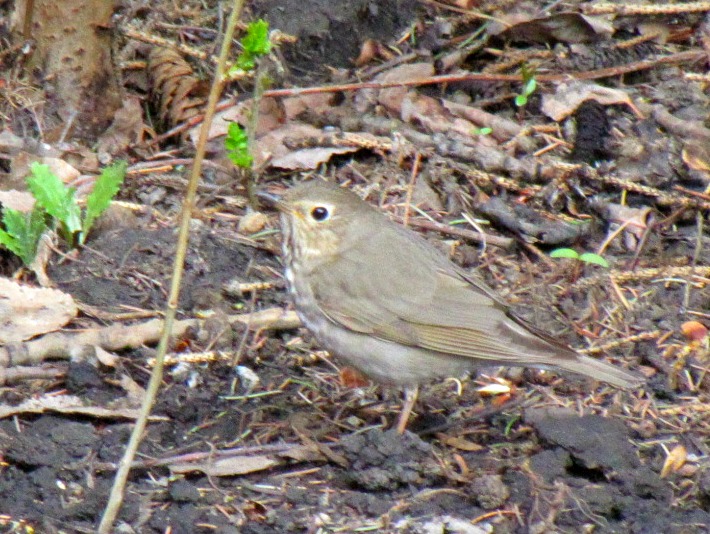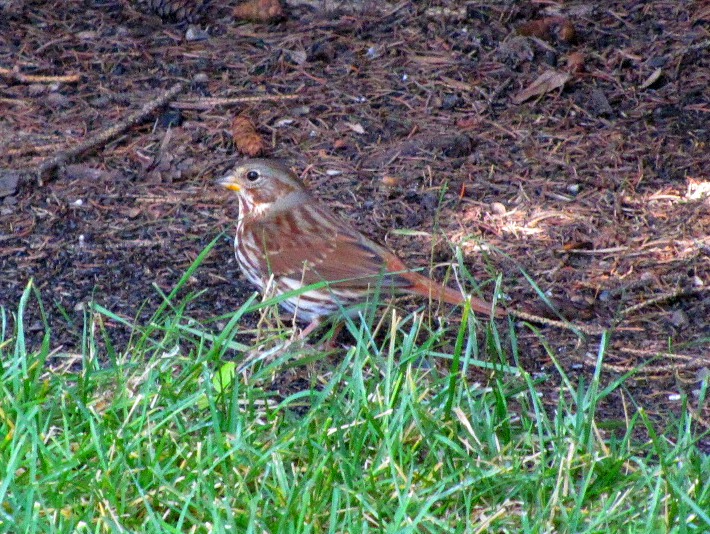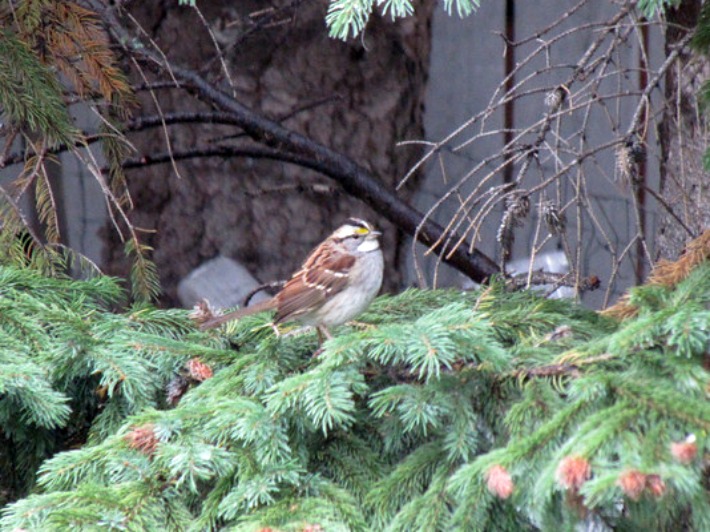Here I was, all excited to get to species number one hundred on my yard list. I keep track of the birds actually in the yard, as well as those seen from the yard, as in flying over (F).
This is a rather bizarre list, as we live in the foothills between the boreal forest and the prairie grasslands, and birds come from both ecozones. We live a block from the Bow River, which swans, cranes and other birds use as a road map during migration.
My yard has conifers, deciduous trees, fruiting shrubs, 11 birdfeeders, and 3 birdbaths. Even with all this, there is absolutely no explanation for the hooded warbler, who should have been in Florida for the 3 autumn months he was here in 2004.
I was so sure I was carefully updating the list as birds appeared so that the numbers were correct. I had even written a one-hundredth-bird-in-the-yard blog post in my head.
Sigh. Meet yard bird #102.
Apparently I wasn’t as meticulous as I thought. It turns out I forgot to add the white-throated and fox sparrows that showed up last year.
And before I could even get this post written, a least flycatcher hopped onto the yard list at #103, and no, I don’t have a picture of it. Trying to capture a tiny flycatcher with a point-and-shoot camera is my definition of insanity…
So here’s the list as it now stands. With this post written, I’m heading onto the back deck to see if I can add to it!
- American White Pelican (F)
- Great Blue Heron (F)
- Trumpeter Swan (F)
- Canada Goose (F)
- American Wigeon (F)
- Mallard (F)
- Common Goldeneye (F)
- Osprey (F)
- Bald Eagle (F)
- Sharp-shinned Hawk
- Swainson’s Hawk (F)
- Red-tailed Hawk (F)
- American Kestrel
- Merlin
- Peregrine Falcon (F)
- Prairie Falcon (F)
- Chukar
- Sandhill Crane (F)
- Franklin’s Gull (F)
- Ring-billed Gull (F)
- California Gull (F)
- Rock Pigeon
- Mourning Dove
- Budgerigar (yes I know, but it was flying around the neighborhood for months)
- Great Horned Owl
- Long-eared Owl
- Boreal Owl
- Northern Saw-whet Owl
- Common Nighthawk (F)
- Ruby-throated Hummingbird
- Northern Flicker
- Downy Woodpecker
- Hairy Woodpecker
- Pileated Woodpecker
- Western Wood-Pewee
- Willow Flycatcher
- Least Flycatcher
- Eastern Phoebe
- Northern Shrike
- Gray Jay
- Blue Jay
- Black-billed Magpie
- American Crow
- Common Raven
- Tree Swallow
- Bank Swallow (F)
- Barn Swallow (F)
- Black-capped Chickadee
- Mountain Chickadee
- Red-breasted Nuthatch
- White-breasted Nuthatch
- Brown Creeper
- House Wren
- Golden-crowned Kinglet
- Ruby-crowned Kinglet
- Veery
- American Robin
- Hermit Thrush
- Swainson’s Thrush
- Gray Catbird
- European Starling
- Bohemian Waxwing
- Cedar Waxwing
- Tennessee Warbler
- Orange-crowned Warbler
- Yellow Warbler
- Yellow-rumped Warbler
- Cape May Warber
- Blackburnian Warbler
- MacGillivray’s Warbler
- Hooded Warbler
- Ovenbird
- Wilson’s Warbler
- Western Tanager
- American Tree Sparrow
- Chipping Sparrow
- Clay-colored Sparrow
- Fox Sparrow
- Savannah Sparrow
- White-throated Sparrow
- Grasshopper Sparrow
- Song Sparrow
- Lincoln’s Sparrow
- Harris’s Sparrow
- White-crowned Sparrow
- Golden-crowned Sparrow
- Dark-eyed Junco
- Red-winged Blackbird
- Yellow-headed Blackbird
- Rusty Blackbird
- Brewer’s Blackbird
- Common Grackle
- Brown-headed Cowbird
- Baltimore Oriole
- Pine Grosbeak
- Cassin’s Finch
- House Finch
- Red Crossbill
- White-winged Crossbill
- Common Redpoll
- Pine Siskin
- American Goldfinch
- House Sparrow






Very nice captures Pat! That is an impressive yard list you have there.
Great photos Pat! That’s an impressive yard list.
Why indeed? Well, those three species are an early start on your way to 200 yard birds.